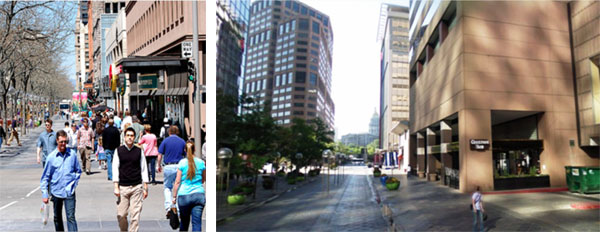C200: What Would Jane Do? (The Granular City as a Mediator of Change)
There’s been some Jane Jacobs-bashing lately in the more-urbany-than-thou circles in which I sometimes travel, and I just won’t stand for it. Respected colleagues have been complaining that Jacobs did us a disservice by failing to prescribe policy, but that wasn’t her M.O, and it’s not as if we’ve excelled at picking up where she left off. Now we have Ed Glaeser’s recent suggestion that Jacob’s ideas about preservation were naïve, and that she didn’t really “get†density, or at least not the skyscraper version that he subscribes to.
Jacob’s work, or at least my reading of it, celebrates fine urban grain and repurposed buildings not for their static qualities but as necessary mediators of change. Jacobs didn’t say that buildings need to be short instead of tall or old instead of new, but rather that we need a diversity of them in order for new residents and businesses to get a foothold and move up the ladder of social and economic development. She promoted an incrementalist approach to densification because the economics of colossal new projects make them “inherently inefficient for sheltering wide ranges of cultural, population, and business diversity.†She exposed the incubator capacity of granular neighborhoods, and the multiple reasons why small independently-owned companies (the ones with the largest local multiplier effect) don’t tend to locate in cavernous downtowns.
She also pointed out that bigger projects mean more egregious errors. Design is subjective, but we can probably all agree that big-block sites do not, as a rule, seem to inspire the architecture profession’s best work. Unlike skinny infill, the big shiny mistakes aren’t easily absorbed into our existing urban fabric. And when they replace older pieces of granular city that have real value in terms of both function and identity, for newcomers and old-timers alike, we shouldn’t be surprised if density becomes a dirty word.
There is a temporal quality to the production of sustainable urban form that is perhaps difficult for macro-economists and policy-makers to recognize. It isn’t reflected in static measures of square footage or units or building heights, but rather in a slow but steady turning of the dial toward a higher intensity of users, connection and access, resource efficiency, character and identity, and choices.  Jane would no doubt remind us that the critical issue isn’t what density should look like, or how much is enough, but rather how we insert it more surgically and gracefully.

< Two views of 16th Street, Denver; photos: Matthew Blackett, Google Streets >
>>>
Liz Dunn is the principal of Dunn & Hobbes, LLC, a developer of adaptive reuse and small-scale infill projects in Seattle, and is currently the Consulting Director of the National Trust’s Preservation Green Lab.

